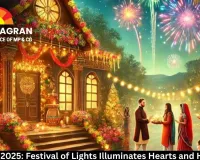Post-Diwali Glow: Celebrating Govardhan Puja and Bhai Dooj in October 2025
Digital Desk

As the lamps of Diwali continue to flicker on October 21, 2025, India's festive spirit refuses to dim. With Diwali celebrated vibrantly on October 20, the nation now turns to the heartfelt rituals of Govardhan Puja and Bhai Dooj—two jewels in the post-Diwali crown that fall squarely in October.
These festivals, steeped in Hindu lore, emphasize gratitude, protection, and sibling love, offering a perfect antidote to the year's hustle. In a time when families are still basking in Lakshmi's blessings, these October celebrations in 2025 remind us of deeper spiritual connections, blending mythology with modern joy.
Govardhan Puja, observed on October 22, 2025, honors Lord Krishna's legendary feat of lifting the Govardhan Hill to shield villagers from Indra's wrath. This eco-conscious festival, also known as Annakut, celebrates nature's bounty and humility over hubris. Across North India, especially in Uttar Pradesh, Gujarat, and Maharashtra, communities craft miniature Govardhan mounds from cow dung, adorned with flowers and diyas. Devotees offer 56 or 108 vegetarian dishes—symbolizing the hill's abundance—in a grand feast called Annakut, shared communally.
Astrologers highlight the auspicious muhurat from 6:45 AM to 8:30 AM on Wednesday, aligning with the Pratipada tithi of Kartik month for maximum blessings. In 2025, with climate change looming large, Govardhan Puja gains renewed relevance; environmental groups promote sustainable practices like using biodegradable materials, turning temples into green hubs. Social media is abuzz with #GovardhanPuja2025, featuring DIY hill tutorials and farm-to-table recipes, as e-commerce sees a 25% rise in eco-friendly puja kits.
Just a day later, on October 23, 2025, Bhai Dooj—affectionately called Yama Dwitiya—wraps up the Diwali festivities with a tender focus on sibling bonds. Drawing from the myth of Yamuna saving her brother Yama, the god of death, sisters apply a protective tilak of vermilion and rice on their brothers' foreheads, performing aarti amid chants of well-wishes for longevity.
Brothers reciprocate with gifts, from traditional sweets like besan laddoos to personalized gadgets, sealing a vow of lifelong support. Regional flavors add charm: Bengal's Bhai Phonta uses ink dots for warding off evil, while Nepal's Bhai Tika includes five colorful tikas. The ideal timing? Between 7:00 AM and 9:00 AM, ensuring the day's energy amplifies familial harmony.
These October 2025 post-Diwali festivals aren't just rituals; they're lifelines in a fast-paced world. Amid India's economic rebound, they foster community resilience—think virtual pujas for NRIs via apps, or hybrid feasts blending home-cooked meals with delivery delights. Religious scholars note how Govardhan teaches environmental stewardship, while Bhai Dooj champions gender solidarity, encouraging brothers to uplift sisters' aspirations.
From Mathura's bustling Annakut bazaars to Mumbai's sibling selfie sprees, October 2025's Govardhan Puja and Bhai Dooj invite everyone to pause, pray, and partake. As the monsoon recedes and winter whispers, these celebrations illuminate paths of gratitude and love. Whether building a tiny hill or tying a rakhi anew, embrace the magic—Diwali's light endures through October's sacred days.

2.jpg)

1.jpg)
.jpg)






